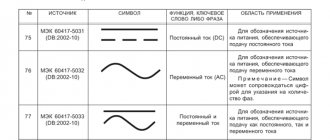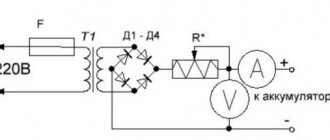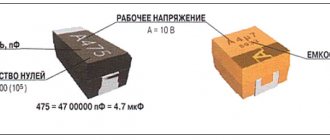What capacity should you choose a battery?
The battery is selected by capacity, based on the brand of car and engine power. In other words, the manufacturer of a particular car model has already selected the optimal battery option. The parameters of this energy source are indicated in the vehicle documentation.
In addition, you can always lift the hood and look at the battery markings.
What should the battery capacity be? When replacing the battery, you can install the device with exactly the same parameters as before. But it is also possible to install a battery with a larger or smaller capacity. It is worth noting that with a larger value of this parameter, the battery will take longer to discharge, but will also take longer to charge. And when the Ampere-hours decrease, on the contrary, it decreases. That's the whole difference!
Is it possible to somehow restore the battery capacity? In some cases this is possible, but the process is very labor-intensive, and the costs are not justified. It's easier and cheaper to replace the battery.
Methods for determining capacitance indicators
What is battery capacity?
Let us describe the most common ways to check the capacity of a car battery. These 2 methods have proven themselves to be the best and are widely used today.
Long Discharge Method
This method has found its application in laboratory conditions. There are also a household method and a method based on long-term charging. Let's take a closer look at all three:
- Standard method (laboratory). To check, the battery must be charged as much as possible and discharged using a minimum current. At the same time, the amount of time during which the discharge occurs is taken into account. The battery capacity, as described above, is nothing more than the product of time and current strength. The complexity of measurements in this case depends on maintaining a constant current discharge using specialized equipment, which is why the method is laboratory.
- Household method. You can check the battery capacity using a constant load. In this case, they use car lamps, creating a load with their help. By analogy with the first method, the time is calculated in parallel in hours. This procedure has its own error, since the load current gradually decreases and the final result of determining the capacitance is not entirely accurate. It is worth noting that the power source should not be allowed to completely discharge, as this may cause it to fail.
- Method based on long-term charging. In this case, an electronic clock and the electrical circuit to which it is connected are used. The diagram itself can be easily found on the Internet. Measurements are carried out over 20 hours.
Method using an electronic tester
This method compares favorably with others in that it is carried out in a shorter period of time. To carry it out, you will need a special device - a tester, which can simultaneously analyze a series of necessary measurements.
The testers operate automatically and do not require special knowledge from the person taking the measurements. Its operating time takes only 10 – 15 seconds. The device easily connects to a power source and has only one button that starts the capacitance measurement process.
The selection of a battery is made based on a comparison of the residual capacity and the nominal capacity, which is indicated by the manufacturer in the battery passport. The difference should not exceed 50%, otherwise such a power source is not ready for further use.
Multimeter method
This device allows you to measure not only battery capacity, but can also be used as an ohmmeter and voltmeter. Measuring the battery capacity with a multimeter is not difficult if you follow the following steps exactly as they are listed below:
- The device must be switched to continuous measurement mode.
- Next, a range is established that is slightly larger than that stated in the battery passport.
- A special black probe is connected to the socket (-).
- The red probe is connected to the socket (+) in the same way.
- The readings are read and displayed.
- At the end of the measurement procedures, the electrical circuit is disconnected.
This text provided comprehensive answers to questions such as: what is needed in order to measure the battery capacity? How to measure? How to find out or how to determine capacitance indicators? The most popular methods and methods of measurement were described. All this information will be useful to every car enthusiast, because knowledge in this area will help in the future when choosing a specific battery. A charger and these skills will keep your power source in working condition much longer.
Is it possible to increase the capacity
Is it possible to check the battery capacity with a multimeter and how to do it?
The battery capacity can be increased only slightly. In general, this process has two sides to the “coin”:
- On the one hand, this is necessary if additional electrical equipment is connected to the on-board network. In addition, in the cold season, the capacity reserve is very useful, because when the air temperature decreases by one degree, the power correspondingly decreases by 1 Ah.
- On the other hand, when not operating in standard mode, the starter is subject to greater wear. And also the generator characteristics may not be sufficient to fully charge the battery.
What affects the battery capacity under real operating conditions?
The actual capacity of a car battery, as a rule, differs from the nominal one. The longer the battery life, the more significant its reduction. There are several reasons that provoke this process:
- terms of Use;
- features of meeting deadlines and service technology;
- battery charging method.
Battery Maintenance Rules
How to check the capacity of a 18650 battery with a multimeter
The main purpose of a battery in a vehicle is to start the car engine. In addition, the battery becomes an emergency power source if the generator fails. There are requirements for the operation and maintenance of batteries that every car owner should know.
It is recommended not to remove the battery from vehicles with the engine running. This in some cases can damage the integrity of the generator. Before removing the battery, you need to turn on a 12 V incandescent lamp in parallel with it. In this case, the circuit will not open and the generator will not work on itself. Most of the batteries that are currently produced are lead-acid, and they use the double sulfation option.
This technology has existed since 1858 and is still used in its original form today. True, recently, batteries for cars with immobilized electrolyte have been produced to a greater extent. They are able to work in all spatial positions. The battery consists of a container in which there are six separate sections. Each section produces independent energy, and since there are plates, the process of electrolysis occurs. The mass of the battery is 16-17 kilograms, it includes: electrolyte, lead plates, as well as additional connections.
How does the battery work? The principle of its operation is very simple. There is dark brown lead oxide on the anode. On the cathode there is spongy gray lead, inside there is a solution of sulfuric acid (electrolyte). During the chemical reaction, zinc sulfate is formed and energy is released. In order to maintain the battery, no special actions need to be taken.
There are four main battery options, namely:
- serviced;
- unattended;
- hybrid;
- low maintenance.
Let's talk about all the varieties in a little more detail, since they are all used to some extent in everyday life and in technology.
- Serviced batteries are produced in small quantities and are more often found in highly specialized industries. They are expensive and not resistant to temperature changes. That is, at low temperatures they can spontaneously discharge.
- Low-maintenance batteries are widespread, their prices vary widely, they are reliable and durable.
- Maintenance-free batteries are suitable for those who do not want to spend effort on caring for the battery.
- Hybrid batteries are more expensive and are rare. It is better to leave charging batteries to professionals.
In order for the battery charging process to be safe, it is advisable to carry out such activities outside the living area. The fact is that when charging, hydrogen vapor is released, which can ignite. Therefore, charging the battery near open sources of fire is strictly prohibited.
Monoblock
You can assemble a battery from individual batteries using a copper wire or a bus bar with terminals. This process, although simple, is still quite labor-intensive, so ready-made monoblocks are made in factories. They consist of several elements assembled in one case made of durable plastic. Monoblock lead-acid batteries typically consist of 6 or 12 individual cells. The voltage is 12 V or 24 V, respectively.
All elements of the monoblock are no different from each other, and they age simultaneously, so the service life of the monoblock is longer than that of each individual battery. In the process of assembling a monoblock, it is possible to use both parallel and serial connections of its individual elements.
Note! Battery life is measured not in years or months, but in the number of charging cycles. To ensure that the battery lasts as long as possible, it is advisable to recharge it after using only a small part of its rated capacity.
How long to charge a car battery
It is impossible to drive without a battery. It supplies electricity to the ignition coil, circuits, and starter. This is a DC source that is used when the car is parked with the engine off and when the engine is running. It is constantly recharged while driving from an alternator or from a rectifier.
If you rarely use your car, be prepared for the battery to drain. This happens especially quickly in winter. This is because during idle time, energy is still used to maintain the operation of devices such as a computer, control unit, watch. Therefore, the battery must be connected to a charger every 3-4 weeks.
Three main factors influence how long it takes to charge a battery:
- battery discharge percentage;
- ambient temperature;
- current strength at the output of the charger.
It is optimal when the charging current is from 0.05 to 0.1 battery capacity. For example, if the capacity is 60 Ah, the optimal charging current will be 3 A, and the maximum allowable 6 A.
When using a current of 0.05 of the capacity, charging will take much longer, but the active masses in all plates will be completely restored. The battery will hold a charge longer and its service life will increase.
It should be taken into account that low temperatures reduce battery parameters. If a cell has 100% electrical capacity at 25°C, then at 0°C it drops to 80%, and at -25°C it drops to 60%. Therefore, if the battery is partially discharged or not sufficiently charged, it may stop working at any time.
How to use the battery charging time calculator
It is very important to charge the battery correctly. Since it is impossible to determine by appearance what level the charging is at, it is very important to know how much time is needed for this process
A battery charging time calculator will help you here. After entering basic data such as
- rated capacity,
- degree of discharge (in percent),
- charging current.
Just click on the “Calculate” button and as a result you will get the time required for charging. For example, if the battery capacity is 60 Ah and it is 80% discharged, then it will take 16 hours to restore its energy reserve (charging current 6A).
Very important amendment
The above formula is approximately correct for long operating times of the UPS from the battery (more than 8-10 hours). At short discharge times (high discharge currents), the battery releases only part of its capacity. This exact value can be found out from the technical characteristics of the battery, and is approximately reflected in the graph.
Therefore, if according to the above formula the time is about 6 hours, it needs to be reduced by 20%. For 4 hours - reduce by 30%, for 2 hours - by 40%, and if the calculation turns out to be about 30 minutes, it needs to be divided by 2.
To accurately calculate the operating time of a UPS from a battery, you need to use the exact efficiency values of the UPS inverter at a given power and the discharge curves of a given type of battery.
Source
How is capacity calculated?
When calculating the battery capacity, you need to remember that the battery cannot be completely discharged - you should leave at least 30% of its charge. The value of this parameter must satisfy the needs of the vehicle’s autonomous power supply system.
Let's look at an example of how to correctly calculate the battery capacity. Let’s say the total power of the car’s electrical appliances is 500 Wh. The voltage value of all batteries is the same and is 12 V. The amount of energy that a battery is capable of producing is equal to the product of its capacity and voltage, that is:
Q = E × U, where
Q – amount of energy stored by the battery; E – battery capacity; U – battery voltage = 12 V.
Since the battery energy can only be used by 70%, therefore, the formula for the amount of energy supplied by the battery will be as follows: Q = E × U × 0.7.
How to calculate the battery capacity in this case? From the expression it is easy to determine E = Q / (U × 0.7).
At Q = 500 Wh
E = 500 / (12 × 0.7) = 59.52 Ah.
Thus, we find that a battery with a capacity of 60 Ah is required. What does this battery capacity mean for a car? The fact that the discharge current value is 60 Amperes.
How to calculate capacitor capacity
The value of the capacitance of the capacitor is influenced by the following indicators: the distance between the plates, their area, the relative dielectric constant of the medium that is located between them. There is an inverse proportional relationship between the capacitance of the capacitor and the first of the above parameters, and its direct dependence on the other two.
1. To determine the capacitance of a capacitor, it is necessary, first of all, to calculate the area of its plates. If it is different, its smaller value is taken into account. The shape of the plate determines the calculation method.
- For the rectangular version: S = ab. Here: S – area (measured in m2); a–length (measured in m); b-width (measure in m)
- For the round version: S = π(R^2). Here: S – area (measured in m2); π – number “pi”; R – radius (measured in m).
In some designs, it happens that the covers are rolled up. Then the area is calculated for the unfolded plates.
2. The dielectric constant of the area located between the two plates also affects the capacitance value of the capacitor. Its indicators can be found in the table at the end of the article. It is a dimensionless quantity and in a vacuum is equal to 1. In air, the permeability value is approximately 1.00058986, which allows us to consider it equal to unity in most calculations. To do this, use the following formula: C = (ε abs. vac. * ε rel. matter* S)/d. Here: C – capacitance (measured in Farad); ε abs. vac. – absolute dielectric constant of vacuum, equal to 8.85418 (measured in F/m); ε rel. thing * S–relative dielectric constant of a substance (dimensionless value); S – area of the smallest of the covers (measured in m2); d – distance between the plates (measured in m).
3. On operating capacitors, capacitance is usually indicated in pico-, nano- or microfarads. Therefore, it is recommended to convert the values obtained during the calculation into the appropriate dimension for a more convenient presentation in the diagram.
Simplified calculation of heat loss compensation
Any calculations are based on certain principles. The calculations of the required thermal power of batteries are based on the understanding that well-functioning heating devices must fully compensate for the heat losses that occur during their operation due to the characteristics of the heated premises.
For living rooms located in a well-insulated house, located, in turn, in a temperate climate zone, in some cases a simplified calculation of compensation for heat leakage is suitable.
For such premises, calculations are based on a standard power of 41 W required to heat 1 cubic meter. living space.
In order for the thermal energy emitted by heating devices to be directed specifically at heating the premises, it is necessary to insulate walls, attics, windows and floors
The formula for determining the thermal power of radiators necessary to maintain optimal living conditions in a room is as follows:
Q = 41 x V,
where V is the volume of the heated room in cubic meters.
The resulting four-digit result can be expressed in kilowatts, reducing it at the rate of 1 kW = 1000 W.
How to measure battery voltage correctly
The most accurate values can be obtained by performing a set of diagnostics. To do this, you need to have special devices with you (multimeter, voltmeter or load plug). To measure voltage from the battery, it is necessary to connect the contacts of the device and the battery terminals.
During diagnostic procedures, it is worth understanding that the power source connected to the vehicle’s on-board system consumes energy. Therefore, the readings may be slightly lower, but they should not fall below 11-11.5 volts. Carrying out correct measurements is permissible on a completely disconnected and charged battery, that is, the electrical circuit must be open. However, this is an optional condition: if you check the voltage in a closed circuit, then take into account a certain error.
- The battery is connected to the system of a car that is not started. Under this condition, the on-board network consumes a certain amount of energy, so the voltage indicator should be in the range of 12.5-13.0 V.
- With the car running and the energy consumption sources turned off, the device readings should vary between 13.5 and 14 volts. Higher readings indicate that the battery is discharged and the generator is not operating normally. It is worth considering that an increase in data in the cold season is not an accurate indication of a low battery. If the voltage is within limits for some time, then the system is fully operational. Reduced readings (from 13 to 13.4 volts) indicate some discharge of the battery. Battery needs charging.
- With the car running and power consumption sources turned on, the voltage value should be greater than 12.8-13.0 V.
Please note that working with a multimeter or voltmeter allows for an inverse relationship between the poles of the measuring device and the battery terminals. The load plug must be used strictly in accordance with the polarity. We do not recommend checking your car's battery voltage using the on-board system because it is not directly connected to the battery
Therefore, certain measurement errors are allowed
We do not recommend checking your car's battery voltage using the on-board system because it is not directly connected to the battery. Therefore, certain measurement errors are allowed.
Checking the battery charge by voltage is recommended some time after the car battery is fully charged, as well as at operating temperature (about 20 degrees Celsius).
Below is the table “Battery charge level by voltage”.
| Battery charge level | Open circuit voltage of low-antimony (Sb/Sb) and hybrid (Sb/Ca) batteries, volts | Open circuit voltage in calcium (Ca/Ca) and AGM/Gel (Ca/Ca) batteries, volts |
| 100% | 12,516—12,663 | 12,666—12,813 |
| 75% | 12,316—12, 463 | 12,466—12,613 |
| 50% | 12,106—12,253 | 12,266—12,413 |
| 25% | 11,926—12,073 | 11,866—12,013 |
| 0% | 11,756—11,903 | 11,666—11,813 |
Table 1. Battery charge level by voltage.











